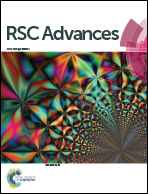A rationally designed molecule for removal of cyanide from human blood serum and cytochrome c oxidase†
Abstract
Compound 3 having three dimethoxyphenolic units exhibited excellent selectivity and competitive binding with CN−. Various experiments revealed the capability of this compound to act through all the three dimethoxyphenolic units and efficiently remove cyanide from human blood serum – more precisely from cytochrome c oxidase.


 Please wait while we load your content...
Please wait while we load your content...